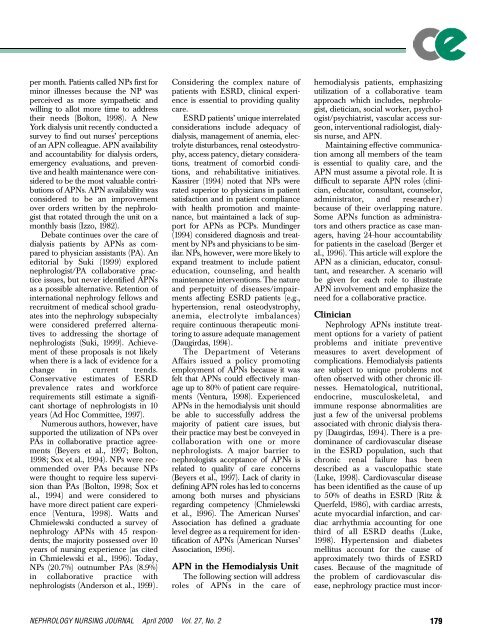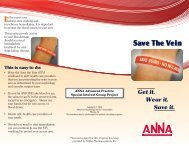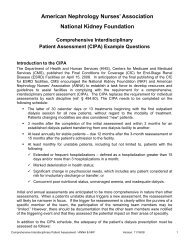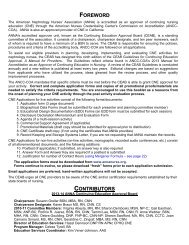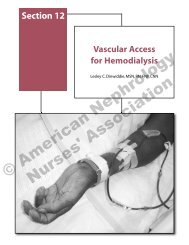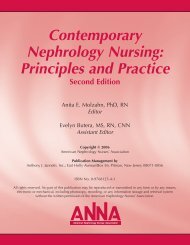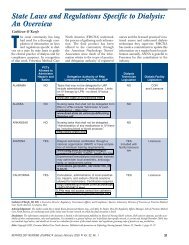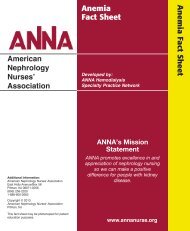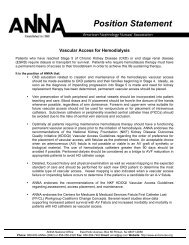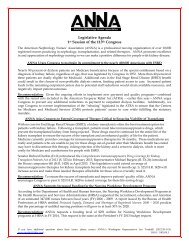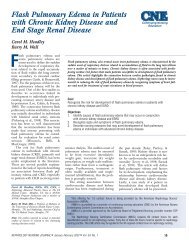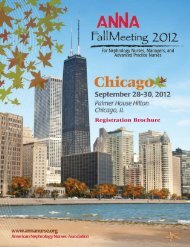Advanced Practice Nurses: Roles in the Hemodialysis Unit
Advanced Practice Nurses: Roles in the Hemodialysis Unit
Advanced Practice Nurses: Roles in the Hemodialysis Unit
Create successful ePaper yourself
Turn your PDF publications into a flip-book with our unique Google optimized e-Paper software.
per month. Patients called NPs first for<br />
m<strong>in</strong>or illnesses because <strong>the</strong> NP was<br />
perceived as more sympa<strong>the</strong>tic and<br />
will<strong>in</strong>g to allot more time to address<br />
<strong>the</strong>ir needs (Bolton, 1998). A Ne w<br />
York dialysis unit recently conducted a<br />
survey to f<strong>in</strong>d out nurses’ perceptions<br />
of an APN colleague. APN availability<br />
and accountability for dialysis orders,<br />
emergency evaluations, and preventive<br />
and health ma<strong>in</strong>tenance were considered<br />
to be <strong>the</strong> most valuable contributions<br />
of APNs. APN availability was<br />
considered to be an improvement<br />
over orders written by <strong>the</strong> nephrologist<br />
that rotated through <strong>the</strong> unit on a<br />
monthly basis (Izzo, 1982 ) .<br />
Debate cont<strong>in</strong>ues over <strong>the</strong> care of<br />
dialysis patients by APNs as compared<br />
to physician assistants (PA). An<br />
editorial by Suki (1999) explored<br />
n e p h r o l o g i s t /PA collaborative practice<br />
issues, but never identified APN s<br />
as a possible alternative. Retention of<br />
<strong>in</strong>ternational nephrology fellows and<br />
recruitment of medical school graduates<br />
<strong>in</strong>to <strong>the</strong> nephrology subspecialty<br />
were considered preferred alternatives<br />
to address<strong>in</strong>g <strong>the</strong> shortage of<br />
nephrologists (Suki, 1999). Ach i e v ement<br />
of <strong>the</strong>se proposals is not likely<br />
when <strong>the</strong>re is a lack of evidence for a<br />
change <strong>in</strong> current trends.<br />
Conservative estimates of ESRD<br />
prevalence rates and workforce<br />
requirements still estimate a significant<br />
shortage of nephrologists <strong>in</strong> 10<br />
years (Ad Hoc Committee, 1997 ) .<br />
Numerous authors, however, have<br />
supported <strong>the</strong> utilization of NPs over<br />
PAs <strong>in</strong> collaborative practice agreements<br />
(Beyers et al., 1997; Bolton,<br />
1998; Sox et al., 1994). NPs were recommended<br />
over PAs because NP s<br />
were thought to require less supervision<br />
than PAs (Bolton, 1998; Sox et<br />
al., 1994) and were considered to<br />
have more direct patient care experience<br />
(Ventura, 1998). Watts and<br />
Chmielewski conducted a survey of<br />
nephrology APNs with 45 respondents;<br />
<strong>the</strong> majority possessed over 10<br />
years of nurs<strong>in</strong>g experience (as cited<br />
<strong>in</strong> Chmielewski et al., 1996). To d a y ,<br />
NPs (20.7%) outnumber PAs (8.9%)<br />
<strong>in</strong> collaborative practice with<br />
nephrologists (Anderson et al., 1999 ) .<br />
Consider<strong>in</strong>g <strong>the</strong> complex nature of<br />
patients with ESRD, cl<strong>in</strong>ical experience<br />
is essential to provid<strong>in</strong>g quality<br />
c a r e .<br />
ESRD patients’ unique <strong>in</strong>terrelated<br />
considerations <strong>in</strong>clude adequacy of<br />
dialysis, management of anemia, electrolyte<br />
disturbances, renal osteodystrophy,<br />
access patency, dietary considerations,<br />
treatment of comorbid conditions,<br />
and rehabilitative <strong>in</strong>itiatives.<br />
Kassirer (1994) noted that NPs were<br />
rated superior to physicians <strong>in</strong> patient<br />
satisfaction and <strong>in</strong> patient compliance<br />
with health promotion and ma<strong>in</strong>tenance,<br />
but ma<strong>in</strong>ta<strong>in</strong>ed a lack of support<br />
for APNs as PCPs. Mund<strong>in</strong>ger<br />
( 1994) considered diagnosis and treatment<br />
by NPs and physicians to be simi<br />
l a r. NPs, however, were more likely to<br />
expand treatment to <strong>in</strong>clude patient<br />
education, counsel<strong>in</strong>g, and health<br />
ma<strong>in</strong>tenance <strong>in</strong>terventions. The nature<br />
and perpetuity of diseases/impairments<br />
affect<strong>in</strong>g ESRD patients (e.g.,<br />
hypertension, renal osteodystrophy,<br />
anemia, electrolyte imbalances)<br />
require cont<strong>in</strong>uous <strong>the</strong>rapeutic monitor<strong>in</strong>g<br />
to assure adequate management<br />
(Daugirdas, 1994 ) .<br />
The Department of Veterans<br />
Affairs issued a policy promot<strong>in</strong>g<br />
employment of APNs because it was<br />
felt that APNs could effectively manage<br />
up to 80% of patient care requirements<br />
(Ventura, 1998). Experienced<br />
A PNs <strong>in</strong> <strong>the</strong> hemodialysis unit should<br />
be able to successfully address <strong>the</strong><br />
majority of patient care issues, but<br />
<strong>the</strong>ir practice may best be conveyed <strong>in</strong><br />
collaboration with one or more<br />
nephrologists. A major barrier to<br />
nephrologists acceptance of APNs is<br />
related to quality of care concerns<br />
( Beyers et al., 1997). Lack of clarity <strong>in</strong><br />
def<strong>in</strong><strong>in</strong>g APN roles has led to concerns<br />
among both nurses and physicians<br />
regard<strong>in</strong>g competency (Chmielewski<br />
et al., 1996). The American Nu r s e s ’<br />
Association has def<strong>in</strong>ed a graduate<br />
level degree as a requirement for identification<br />
of APNs (American Nu r s e s ’<br />
Association, 1996).<br />
A PN <strong>in</strong> <strong>the</strong> <strong>Hemodialysis</strong> Un i t<br />
The follow<strong>in</strong>g section will address<br />
roles of APNs <strong>in</strong> <strong>the</strong> care of<br />
hemodialysis patients, emphasiz<strong>in</strong>g<br />
utilization of a collaborative team<br />
a p p r o a ch which <strong>in</strong>cludes, nephrologist,<br />
dietician, social worker, psych o lo<br />
g i s t / p s y chiatrist, vascular access surgeon,<br />
<strong>in</strong>terventional radiologist, dialysis<br />
nurse, and APN .<br />
Ma<strong>in</strong>ta<strong>in</strong><strong>in</strong>g effective communication<br />
among all members of <strong>the</strong> team<br />
is essential to quality care, and <strong>the</strong><br />
A PN must assume a pivotal role. It is<br />
difficult to separate APN roles (cl<strong>in</strong>ician,<br />
educator, consultant, counselor,<br />
adm<strong>in</strong>istrator, and research e r )<br />
because of <strong>the</strong>ir overlapp<strong>in</strong>g nature.<br />
Some APNs function as adm<strong>in</strong>istrators<br />
and o<strong>the</strong>rs practice as case managers,<br />
hav<strong>in</strong>g 24-hour accountability<br />
for patients <strong>in</strong> <strong>the</strong> caseload (Berger et<br />
al., 1996). This article will explore <strong>the</strong><br />
A PN as a cl<strong>in</strong>ician, educator, consultant,<br />
and research e r. A scenario will<br />
be given for each role to illustrate<br />
A PN <strong>in</strong>volvement and emphasize <strong>the</strong><br />
need for a collaborative practice.<br />
Cl i n i c i a n<br />
Nephrology APNs <strong>in</strong>stitute treatment<br />
options for a variety of patient<br />
problems and <strong>in</strong>itiate preventive<br />
measures to avert development of<br />
complications. <strong>Hemodialysis</strong> patients<br />
are subject to unique problems not<br />
often observed with o<strong>the</strong>r chronic illnesses.<br />
Hematological, nutritional,<br />
endocr<strong>in</strong>e, musculoskeletal, and<br />
immune response abnormalities are<br />
just a few of <strong>the</strong> universal problems<br />
associated with chronic dialysis <strong>the</strong>rapy<br />
(Daugirdas, 1994). There is a predom<strong>in</strong>ance<br />
of cardiovascular disease<br />
<strong>in</strong> <strong>the</strong> ESRD population, such that<br />
chronic renal failure has been<br />
described as a vasculopathic state<br />
(Luke, 1998). Cardiovascular disease<br />
has been identified as <strong>the</strong> cause of up<br />
to 50% of deaths <strong>in</strong> ESRD (Ritz &<br />
Querfeld, 1986), with cardiac arrests,<br />
acute myocardial <strong>in</strong>farction, and cardiac<br />
arrhythmia account<strong>in</strong>g for one<br />
third of all ESRD deaths (Luke,<br />
1998). Hypertension and diabetes<br />
mellitus account for <strong>the</strong> cause of<br />
approximately two thirds of ESRD<br />
cases. Because of <strong>the</strong> magnitude of<br />
<strong>the</strong> problem of cardiovascular disease,<br />
nephrology practice must <strong>in</strong>cor-<br />
NEPHROLOGY NURSING JOURNAL April 2000 Vol. 27, No. 2 179


